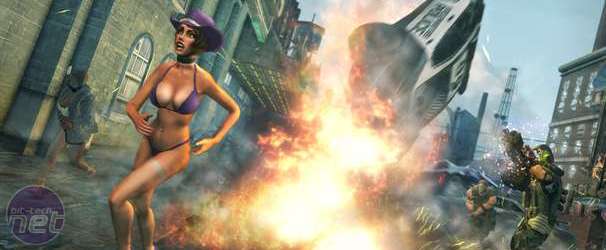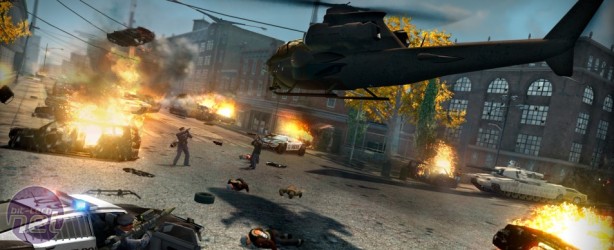Saints Row the Third Review
Publisher: THQPlatform: PC, PS3, Xbox 360
UK price (as reviewed): £38.89 (inc VAT)
US price (as reviewed): $55.58 (ex tax)
If you like games with boobs, guns, explosions, strippers, cars and the ability to beat someone to death with a dildo, then you're in luck. Saints Row: The Third plays like a montage of most teenage boys' more crass interests.
Sharing the same moral outlook and sense of humour as the Crank films, your enjoyment of Saints Row will depend partly on your tolerance for base humour and mild-to-extreme misogyny, all under a thin veil of 'irony'. If you’re willing to let all that slide, then there's certainly some fun to be had with the latest Saints Row.
Since the second game, the Saints have become a multi-million dollar franchise, with energy drinks, television appearances and a movie in the pipeline. The game kicks off with a bank robbery sequence: as tends to happen in these sorts of situations, it all goes awry, and before long you're embroiled in a shoot-out ending in levelled buildings, exploded helicopters and a good hundred-plus police deaths.
This opening introduces the player to the main theme of the game: excessiveness, and the main mechanic: shooting. Ignoring the cover-based systems of most other modern third-person action games, gunfights are about mowing down countless enemies as an almost unstoppable Terminator-like character.
Standing in the open will get you killed, eventually, but most action sections can be played by just walking forward and shooting everything you see. Death is rare thanks to a combination of dumb AI and the responsive controls: aiming feels solid and, apart from a few close-up shotgun misses, hit detection is perfect. Meanwhile, gunfights vary between hectic, well-orchestrated set-pieces and boring corridor shooting, with bad guys lining up to be offed.
The Saints Row series prides itself on being the wacky, over the top counterpart to GTA’s dark satire of the American Dream. This is reflected in exaggerated weaponry; for example, it’s only half an hour or so before UAV drones become part of your permanent arsenal. This extreme approach to engagement makes cruising around Stillwater causing mayhem a lot of fun. Fending off swathes of police and enemy gangs while switching between RPGs, laser guns, flame-throwers and the aforementioned dildo, is great because of the freedom it offers for creative destruction.
Missions also get more outlandish throughout the game, with skydiving shoot-outs, strip-club massacres, helicopter chases and RPG rampages all occurring within the first few hours. Though these sound exciting, their core structure has changed little from the days of Grand Theft Auto 3: go from A to B, sometimes to C, then kill or protect something or someone.
There’s rarely scope for multiple approaches to completing a mission. Special weapons are given and must be used, and strict routes must be followed, or else you fail. However, that’s not to say there’s no fun to be had. Some missions, such as The Club-esque Professor Genki gameshow sections offer genuine variety; despite the rigid linearity of missions, some set-pieces are also simply exhilarating, despite not being able to choose your approach.
Sadly, though, these moments of madness are not as frequent as we’d like, and after the bombastic first act introduces most of the crazy weapons and core gameplay mechanics, the game noticeably slow down as mission types are repeated with no new toys to spice things up. The last third of the game picks up the pace again, amping up the surreal silliness until it borders on science fiction, but for a 40ish-hour game that prides itself on a pumped-up attitude, it’s a shame there are slow patches.

MSI MPG Velox 100R Chassis Review
October 14 2021 | 15:04












Want to comment? Please log in.